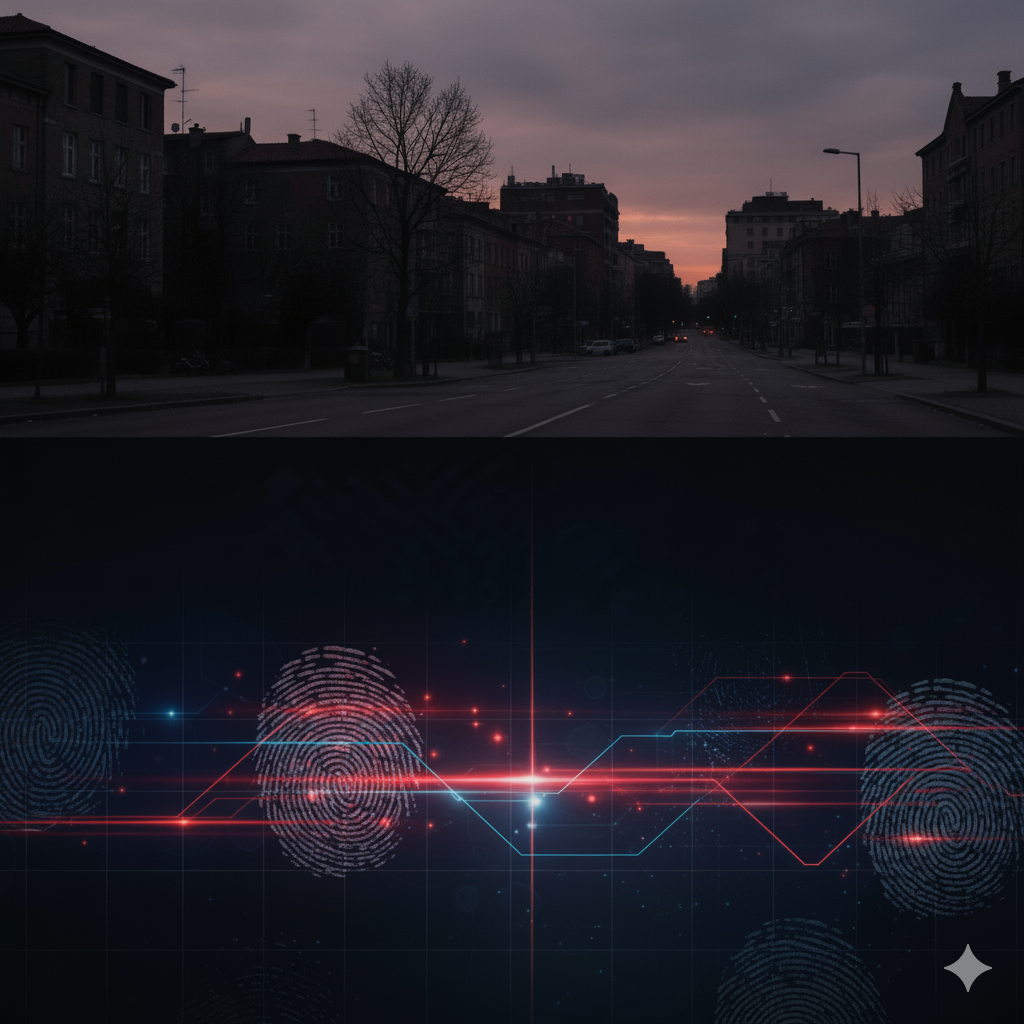ONOF family homicide report october 2-8, 2025: the shattered mirror of relationships
Authored by Tiziana Calzone, Massimo Lattanzi, and Francesca Candus, based on the "Family Crimes" column of the Italian Association of Psychology and Criminology (AIPC).
Abstract
This article analyzes family homicide data collected during the week of October 2-8, 2025, interpreting it through the paradigm of relational psychotraumatology. The analysis outlines a victim profile characterized by substantial gender parity (50% men, 50% women), predominantly in the 36-53 age group (40%), killed in the context of intimate relationships (Partner 30%, Relatives 30%), with a geographical concentration in Southern Italy and Islands (60%). The perpetrator profile is predominantly male (80%), also in the 36-53 age group (50%), acting against a relative (36%), and operating in Southern Italy and Islands (60%). These data, when viewed from a psychotraumatological perspective, do not represent isolated criminal events, but rather the catastrophic outcome of traumatic bonds and histories of Complex Post-Traumatic Stress Disorder (C-PTSD). A comparative analysis with the previous week reveals a disturbing shift in the phenomenon, with a geographical reversal and a change in the victim's demographic profile.
Introduction
The National Observatory on Family Homicides (ONOF), a project of the Italian Association of Psychology and Criminology (AIPC), constantly monitors "family crimes." It is crucial to emphasize that the data analyzed in this column are based on open sources, specifically news reports from journalistic outlets, and not on institutional sources. The category of "family crimes" includes homicides, attempted homicides, and suicides that occur within a degree of "familiarity," broadly understood: from acquaintances to current or past emotional-affective relationships, and kinship.
The work of the AIPC's multidisciplinary team, coordinated by Doctors Massimo Lattanzi and Tiziana Calzone, and with the collaboration of the association's interns, including Dr. Francesca Candus, is founded on a scientific approach aimed at prevention. An example is the A.S.V.S. protocol (AIPC Scientific Violence Screening), a specific risk assessment that integrates clinical interviews and psychophysiological evaluations.
In-depth analysis and commentary: week october 2-8, 2025
The analysis of data collected this week reveals a complex and alarming picture that merits a clinical interpretation through the lens of relational psychotraumatology.
The victim profile: the shattered mirror of relationships
The data delineate a victim whose identity is defined by the rupture of the most intimate bonds.
- Gender and age - a midlife crisis: The perfect gender parity (50% men and 50% women) and the concentration in the 36-53 age group (40%) are clinically crucial data. This phase of life is often a turning point, where unresolved traumas, personal and relational failures, and the pressure of family responsibilities can culminate in profound crises. Lethal violence, in this context, is not a bolt from the blue, but the final act of histories of suffering, often rooted in Complex Post-Traumatic Stress Disorder (C-PTSD). Violence becomes a dysfunctional and tragic "solution" to an emotional pain perceived as intolerable.
- Familiarity and weapon - the proximity that kills: Victims are killed by partners (30%) or other relatives (30%). This confirms that the greatest danger does not come from outside, but from within the domestic walls, from the bonds that should guarantee protection. The prevalent use of a stabbing weapon, especially against male homicide victims (67%), suggests an explosion of anger acted out at close range, a violent and disorganized final interaction, often the result of extreme emotional dysregulation.
- Geography - the epicenter in the south: The concentration of 60% of cases in Southern Italy and Islands could indicate the influence of specific socio-cultural stressors that, combined with individual and family psychological vulnerabilities, create an explosive mixture.
Are your emotional relationships a disaster? Do you find yourself reliving the same dynamics over and over? It's not your fault. It could be Complex Post-Traumatic Stress Disorder, an invisible wound that manifests in the body and in relationships. The campaign "WHO CARES IS SAFE" is the first step to regaining control. Participate in our free screening for young people (18-30) and couples. Places are limited, don't wait. https://www.associazioneitalianadipsicologiaecriminologia.it/articoli/post/247297/campagna-aipc-cipr-e-onof-%E2%80%93-novembre-2025-%E2%80%9Cchi-si-cura-%C3%A8-sicura%E2%80%9D
The perpetrator profile: the tragic face of violence
The perpetrator's profile is sharper and confirms sadly known patterns.
- Gender and age - the masculine and suffering: 80% of perpetrators are men, predominantly in the same age group as the victims (36-53 years old, 50%). This data should not be read as a simple gender statistic, but as an indicator of a profound crisis of masculinity. Often, the inability to process trauma, manage frustration, and communicate pain healthily leads to violent acting-out, where the destruction of the other (and sometimes of oneself) becomes the only perceived way out. The perpetrator and the victim are two sides of the same traumatic coin, trapped in a repeating script of pain.
- Violence towards relatives: The fact that violence is directed primarily towards relatives (36%) suggests that conflicts do not arise only in couple dynamics, but in broader family systems, where attachment wounds and intergenerational traumas have never been healed.
Correlation and comparative commentary with the previous week (september 25 - october 1, 2025)
The comparison with the previous week is disconcerting and demonstrates the chameleon-like nature of the phenomenon. While family violence is a constant, its manifestations change dramatically.
- Geographical and demographic reversal: The most striking variation is the total geographical reversal: from 67% of crimes concentrated in the North last week, the focus shifts to 60% in Southern Italy and Islands this week. In parallel, we witness a transformation of the victim's profile: last week it was predominantly women (67%) and young (18-35 years old); today it is without gender distinction and older (36-53 years old). This shift suggests that, while last week's violence might have been linked to more "classic" couple dynamics in urban and industrialized contexts, this week we might be facing the implosion of extended family systems in contexts with different social and economic pressures.
- From partner to relatives: While partner violence remains a constant, the emergence of "relatives" as a key figure this week (30% of victims and 36% of perpetrators) broadens the scope of the analysis. This is no longer just femicide or couple violence, but a more widespread intra-family violence, which can include conflicts between siblings, parents and children, or those related to care and inheritance, all exacerbated by previous traumatic histories.
- The single, tragic constant: In this constantly changing scenario, one data point remains fixed and terrible: the perpetrator is almost always male. This persistence, regardless of geographical or demographic variations in victims, compels us to question the cultural and psychological roots that link masculinity to violence as a tool for managing conflict and pain. It is proof that, beyond the individual event, deeply rooted traumatic patterns and dysfunctional models are at play.
Conclusions: two stories of suffering, a single traumatic root
In conclusion, the comparison between the two weeks shows not just a cold variation in numbers, but tells two dramatically different stories of human suffering. If the previous week painted the unfortunately more "classic" picture of gender-based violence concentrated in the North, with young female victims at the hands of their partners, this week reveals a different and perhaps even more disturbing narrative: the implosion of the extended family system in Southern Italy. Here, violence makes no gender distinction, striking men and women equally in their adult age, and the threat is not just the partner, but extends to relatives, in an enlargement of the conflict that suggests intergenerational traumas, unresolved feuds, and the collapse of entire family units.
This rapid and radical shift from one week to the next is the most alarming data point. It demonstrates that violence is not a monolithic phenomenon, but a multi-headed hydra that changes its appearance according to geographical, social, and relational contexts. For this reason, it highlights the critical need for constant monitoring, like that carried out by ONOF, and for flexible and tailored prevention interventions. An approach that works to prevent femicide in an urban context might be completely ineffective in defusing a conflict that has been simmering for decades among relatives in a small town.
We must learn to read these diverse manifestations of relational trauma—whether it is the possessive control of a partner or repressed anger in a dysfunctional family dynamic—before the suffering becomes unbearable and culminates in the only, tragic, and irreversible conclusion.
If you have recognized yourself in these stories of pain, or if you feel that complex family dynamics have profoundly influenced your life and emotional regulation, you are not alone. The Italian Centre for Relational Psychotraumatology (CIPR) offers a specialized approach to address relational traumas and support healing.
Our professionals in Pescara and Rome are ready to welcome you with personalized therapeutic paths to help you regain balance and well-being.
For more information or to book an appointment, you can contact us:
- Email: aipcitalia@gmail.com
- Reference Website: https://www.associazioneitalianadipsicologiaecriminologia.it/en/home
- WhatsApp Phone: 3924401930
Do not postpone the opportunity to embark on a journey of change and growth. We are here for you.

.-omicidi-familiari-100-maschili-e-meridionali.-legemonia-della-violenza-intergenerazionale-uomo-su-uomo-nel-sud-italia.jpeg)

